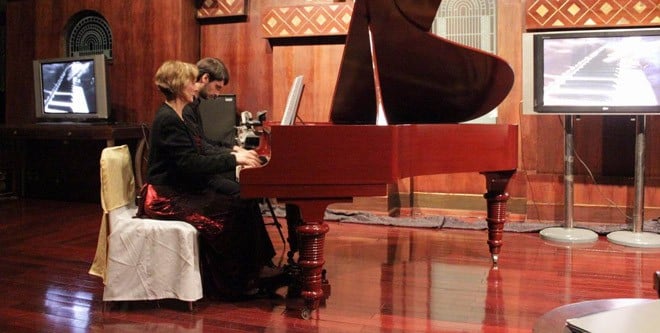

The most intriguing and thus fascinating aspect of the presence of Martine Mirabel-Pitte was her experience and interaction with playing of the Burmese piano. Though she did not give an overt display of this style, if it can be called so, which she had learnt while being in Burma, it was clear from her talk and the discussion that she values it immensely.
At the concert in Lahore, last week, held under the aegis of the French Centre, she played the usual numbers from the very famous European composers like Beethoven, Franz Liszt, and not so well known in Pakistan, the French composer, Gabriel Faure.
She also gave display of the four hand piano.
She goes to Burma quite often and has been actively involved in a teacher-disciple relationship with a well-known Burmese pianist Gita Luvin Maung Koko. She has picked up many niceties of style and techniques associated with the Burmese piano.
Burma and piano may sound odd and incongruous because piano, as it is known, is quintessentially a western instrument or an instrument that highlights the essentials of western classical music as it evolved over the last five centuries. It came into its present recognisable shape and form in the 18th century and some of the greatest exponents like Mozart and Liszt took it to an unprecedented level. Instruments are made or crafted according to the musical requirement of the form and at about that time the need for piano must have been felt since it could distinguish the sound and application of the note from the organ. Gradually, it became more sophisticated, met with the musical requirements of the times and became the most important instrument in the western orchestra by the beginning of the 19th century.
It was introduced to the Burmese society by the middle of the 19th century and, as the story goes, the curiosity of the then Burmese monarch about everything European resulted in its import to the country. This curiosity of the monarch should come as no surprise as the exponential expansion in the 19th century made many non-western societies wanting to emulate the European model. But, it is said, the Burmese took to the piano as a duck takes to water -- and within no time, the instrument was moulded and used in producing the Burmese sounds which to a European ear must have seemed strange.
But, here, the use of instruments crafted in other cultures or representing sound not indigenous has been nothing new. Many of the Central Asian instruments over a period of time have modified and appear to be totally local now. Many have become redundant in the place of their origin but are played widely here.
The most convenient example is of harmonium which is still very popular. Rather, it forms the backbone of any performance. It is played in such a manner that it would still shock the Spanish. The instrument apparently came from Spain, lugged by the Jesuit priests who sang to the accompaniment of this portable instrument liturgical songs, initially in Spanish or Portuguese and then in the local dialects. Harmonium is played in such a manner here that the rough edges of the staccato note are transformed into one continuous melodious flow of notes.
Martine Mirabel-Pitte was interested in music from her childhood, specially her fascination with contemporary forms, like jazz. Gradually, she discovered a taste for the piano and completed her education in the instrument and various forms of western music at the Ecole Normale de Musique de Paris. She then went on to explore other musical forms where piano was used as an instrument with great virtuosity -- and discovered Burma and its fascination with the instrument in this process.
It is hoped that on her next visit, in about six months, she will give a display of the Burmese-style of playing the piano.
Due to her exposure to musical systems of the world, she is not in thrall to the fusion and the ready mixing of music which has been taking place in the world at a breathtaking speed. The coming together of music systems as indeed of other forms in language/literature and systems of ideas take time to assimilate in forming a new whole. The process requires a certain period to mature. But in today’s world the technologies available and the instant exposure to varied systems of ideas and culture have created a switch-on switch-off situation all round.
Musical forms, intonations and systems have influenced each other throughout human history but the pace at which this is being done now is unprecedented. As in the case of the Burmese piano, the two -- one, the system of music and other, the instrument as the product of another musical tradition -- grew into a symbiotic relationship, to a degree that piano may sound very indigenous within the Burmese spectrum of tonal sounds.
Precisely, this is needed these days rather than rushing into the cut and paste gimmick that may produce cacophony of sounds but does not masticate into something that is new and original. Perhaps, the process of production has outpaced the process of creation and the two have failed to be in sync. When the process of creation attains the same speed as production, hopes can rise for something significant taking place.